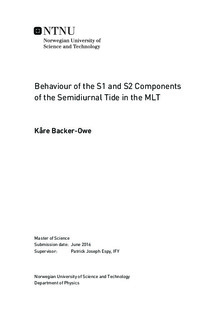Behaviour of the S1 and S2 Components of the Semidiurnal Tide in the MLT
Master thesis
Permanent lenke
http://hdl.handle.net/11250/2398890Utgivelsesdato
2016Metadata
Vis full innførselSamlinger
- Institutt for fysikk [2695]
Sammendrag
9 years (2000-2008) of wind data from a longitudinal chain of up to 10 Super Dual Auroral Radar Network (SuperDARN) radars spanning over 184 degrees in longitude and ranging in latitude from 51.4 - 65.7 degrees N is used to fit the daily meridional semidiurnal amplitudes at different longitudes to extract the zonal wavenumber 1 (S1) and wavenumber 2 (S2) without spatial-temporal aliasing. This thesis focuses on the climatology of the different components, connections to sudden stratospheric warmings (SSW) and the possibility of the auroral electrojet being a generation mechanic for the S1 component. \\\\The climatology shows that the S2 dominates from June to November maximising around fall equinox, followed by another enhancement in winter. The S1 shows an enhancement around the fall equinox. The rest of the year, the S1 and S2 amplitudes are comparable in magnitude. \\\\The behaviour of the S1 and S2 components during SSWs are studied using a super-posed epoch of 7 SSWs accompanied by an elevated stratopause event, and show that the response of the semidiurnal tide to SSW is mainly S2 driven. This means that most of the tidal enhancement during an SSW would be capable of propagating into the ionosphere and initiating the process by which the SSW signature is carried to the equator, as suggested by Chau et al. (2012).
The auroral electrojet is investigated as a possible generation mechanism of the S1 component through joule heating by correlating yearly S1 anomaly data with the AE index. During solar minimum this yields weak correlations (0.2-0.3) significant above the 95% confidence level, and shows a clear repeating 27 day cycle. This repeating pattern is thought to be linked to persisting high-speed solar wind streams associated with coronal holes, adding credibility that there is a weak solar link to the generation of the S1 component, and that it is particle rather than radiatively driven.
